They have seen the victorious
British fleets from that day to this going and coming,
and have carried succour to thousands of ships, both
steam and sailing, year after year, by night and day, in
the dreadful gales against which the anchorage only forms
at best a partial protection. And more than this, manned
by their intrepid Deal crews they have left their
legitimate work, and have risked all in saving ships and
lives from the appalling fury on the dreaded
Goodwins.
These sands, cast up and maintained by
the meeting of the Channel and North Sea tide-streams
which eddy round this spot, rise straight out from
seventy to ninety feet of water. By the tremendous
surface wash of the sea and the strong tide-streams
running violently and varying in direction with the hour
of the tide, they are kept shorn down to some ten feet
below high-water level. Hard as they appear to be in some
places, they yet rapidly swallow up every wreck which
gets upon them, and every beacon which has been erected
in the vain hope of providing a refuge on their
treacherous surface.
No more dangerous work exists in the
world than the rescue of men from a ship which has once
beaten in on the surface of such shallows as the Goodwin.
The true power and horror of a long line of heavy
breakers, rising up in foaming cataracts twenty feet high
and thundering forward thirty miles an hour at hour as
their momentum is checked by the sands beneath, can only
be realised by those who have once been among them and
have survived. Huge seas breaking and roaring in across
the wind, their tops blowing away in sheets of solid
water to leeward, and anon leaping forty feet into the
air as they meet the big line of breakers, add to the
terrible danger of any lifeboat or other which dares
among them. A cross tide-stream running at four or five
knots, the dense drift of sea-spume, the stinging rain,
the gripping, shrieking wind, and the thunder in the
canvas, all add to the appalling confusion.
Yet in such scenes, before the day of
the splendid blue-hulled lifeboats which have earned
undying fame in the hands of the storm warriors of Deal,
Walmer, and Ramsgate, the old brown-hulled, red-sailed
hovelling luggers of Deal*1 brought hope and help to many
a fainting group of desperate men clinging to the last
spars of their once proud ship.
In shore life we record with pride and
speedily reward the bravery of a man who gallops half a
mile under rifle fire to help a wounded comrade out of
action, or who by an instant's presence of mind rescues a
score of people from accident or death. At sea, a dozen
men put off in a small open boat from their snug
firesides. A black winter night and a freezing gale
cannot keep them at home, for they have seen a signal of
distress. It is three hours' beat against the sea and a
lee-going tide, and they are all soaked and numbed to the
bone in half that time. Arrived at the weather end of the
Sands, there is no sign of the wreck. The flares are
burnt out or washed away. But the men who lit them may be
there still: all, or only one. It is an off-chance. But
these twelve men are not going to leave that chance.
'Guess we must wait' is all that is said. Then comes ten
hours' waiting through the black night for the winter
dawn, such waiting as only such men could survive; every
minute in every thundering sea and stinging snow-squall
threatening death. Then at last in the dawn, 'There she
is !' is the cry, and away goes the willing boat under
her close-reefed foresail before the seas, boldly into
the breakers towering above her mast, Without fear or
thought except for those still clinging to the rigging.
Yet the work is not done; now comes effort after effort
to get near the wreck without smashing up the boat and so
bringing death to all. By consummate seamanship and
unerring judgment only is it effected, such swiftness of
hand and eye, such patience and steadiness of heart and
head as would win for this crew unending fame could men
but witness it or understand it as they can a land battle
or even a football match. This is sport indeed; this is
pluck; this is all we venerate, and a good deal more. But
these men are of the sea. Six hours later they are
getting on dry clothes, and the poor rescued wretches are
weeping their gratitude. A paragraph appears in a
newspaper: 'Great Gale. Gallant rescue; the crew of a
barque saved.' And then all is done; the names if ever
known are quickly forgotten; the event is buried in a
score of others; and football gives way to the cricket
season.
*1* The term 'hoveller' was in use in the time of Edward
III to denote the mounted coastguards of the period,
'homines ad arma et hobilers,' used for watching the
Shores, and giving warning of hostile raids in time of
war. It is said to be probably derived either from the
French 'hobil,' a surcoat, or the old English 'hobbier,'
a Stout cob, as suggested in G. B. Gattie's Memorials of
the Goodwin Sands, London, 1893. Knowing how the word
'hoveller' or 'hobler' is used to the present date in
some places in Cornwall to denote a boatman Who plies for
hire and is not a regular fisherman, neither of the above
derivations seems very satisfactory. It is a rare word,
and it is peculiar that it should be used at the two
opposite ends of the Channel to denote practically the
same meaning. Is not 'hoverer' as likely a derivation as
the above somewhat random guesses?
Yet among sailor men, ever shifting as
they are with their fleets about the world, the Deal
boatmen and their old luggers and their newer lifeboats
will never be forgotten. They are heroes of the Empire
second to none, and like heroes are dumb about
themselves.
The old Deal lugger was a bluffer
built vessel than its sister the famous Yarmouth yawl.
But its rig was the same originally when each carried the
old-fashioned three-lug combination derived from the
French and referred to elsewhere. The Deal lugger, like
the Yarmouth boat, has dropped out the mainmast amidships
and retained only the mizen and foresails at either end
of the boat.
These boats have always been launched
and beached with great boldness up and down their steep
beach. They were usually 40 feet long by 13 feet beam,
and had a small forepeak for shelter.
DEAL GALLEY PUNT
Lying stem seawards, with masts
stepped, they were ready for sea night and day at a
moment's notice. They were held fast on the inclined ways
by a chain roved through the 'ruffles' in the keel. When
the trigger was knocked away, with crew on board and
mizen sail set, they would shoot down the beach with
square skids below, head-first into the surf. Often their
own impetus was sufficient to take them off through the
line of breakers, but with an onshore wind a hauloff warp
would be resorted to, the whole crew laying on to it as
she went off; thus ensuring her riding into deep water.
Then up smartly went the foresail, sheet and halyards
being set taut as she drew out.
Landing was even more dangerous,
especially in the case of the more numerous and smaller
galley punts, which must often stand off and on for hours
before they dare risk a smooth to run in upon.
Surf work of this nature is a
speciality, and the Deal and south-coast men are experts
at it; but the deep-water sailor, who knows too well the
power of breaking water, and has a horror of a lee shore,
would, as a rule, prefer any other way to
land.
GALLEY PUNT--ON A WIND
The luggers and galley punts were
alike clench built, and very strong to stand the knocking
about in floating and beaching and the strains at sea,
alongside ships, or carrying heavy weights in bad
weather, to which they were subjected. Both were built of
elm and were kept 'bright' and varnished, being thus
easily recognisable even on a dark night.
The galley punt is, as its name
implies, a boat capable of pulling or sailing. It is
smaller than the old lugger, being from 21 to 30 feet in
length with 7 feet beam. It is still much used for
tending ships in the Downs, lauding pilots, and general
'hovelling' work, and the crew of four men may often be
away for four days at a time on such service, which may
include a tow of fifty miles or more behind a steamer
waiting to take off the pilot. Such work in winter
weather may be best imagined.
The mast is placed well amidships, and
a long-yarded, square-headed dipping lugsail is set upon
it very much like the sail used in the Shetland sexern
and in the Arendal yawl in Norway. It is a very useful
sail, giving great lifting and weatherly power, and is
wonderfully handled. The short mast, its position
amidships, and its lack of gear make it extremely handy
in tending ships.
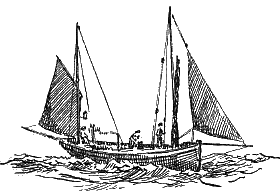
JIB AND MIZEN
The dipping lugsail, the simplest in
rigging, the most powerful on a reach and the flattest to
windward of all known sails, is the sail of the south
coast boatman, with few exceptions, from the Foreland to
Land's End.
The South Coast
From Dover and Folkestone, now quite a
considerable fishing port, westward, the mast is placed
further forward than in the galley punt, and more in the
position of the old Deal lugger, with a mizen and a small
jib on a running bowsprit often added. This gives one of
the handiest of rigs for a comparatively small crew to
handle; it gives an even balance of sail-spread under jib
and mizen for picking up a berth or shooting drift-nets;
keeps the boat under way when the big foresail is dipped;
and splits up the sail area handily for reefing purposes
in a blow.
BRIGHTON CLINKER-BUILT LUGGER
Most yachtsmen have met the Hastings
and Brighton shore-boats up and down Channel in all
weathers and have admired the power in the strong bluff
bows flying dry up and down the steep Channel seas. They
are usually easily recognisable by the peculiar little
counter built out beyond the transom stern, the long pole
on the light mizen-mast, and the straight
mizen-outrigger, carrying on the line of the gunwale, and
never raked up as in the west country boats.
HASTINGS LUGGER
From Shoreham come a finer, deeper
class of carvel-built boat, many of them built down west
in Cornish ports. The advantage of not having to seek
shelter from bad weather up the side of a steep beach is
the greater depth and size, and superior accommodation
and shelter at sea, which can be indulged in.
The curious old Brighton hoggies,
which were common up to the middle of the last century,
and were illustrated by E. W. Cooke, have now quite
disappeared before the superior handiness and sailing
qualities of the south coast lugger.
These boats were quite peculiar, and
were the nearest approach in build to the Dutch
beach-boats of the Scheveningen coast ever seen on these
shores. Like them they were clinker-built, flat-floored,
and round-ended, with great beam and strong bilge-keels.
They carried a sprit or gaff mainsail, and often a sprit
or lug mizen, with a stay foresail set out on a peculiar
flat wooden bumkin, raked well down forward. A running
bowsprit and small jib were occasionally used.
OLD BRIGHTON 'HOGGY'
(AFTER E. W. COOKE 1828)
Some variation seems to have taken
place in their rig prior to the introduction of the now
usual lug- rigged boats; for while for some time they
used the high boomless gaff mainsail familiar in the
little Itchen sloops with perpendicular aft leech, in
Cooke's time they had certainly nearly all adopted a
lower cut spritsail and mizen.
A particularly fine, powerful class of
open clinker-built yawl is used on this coast for
pleasure purposes in the summer, and the splendidly
effective build and rig of these boats is often obscured
by the nature of the service to which they are
put.
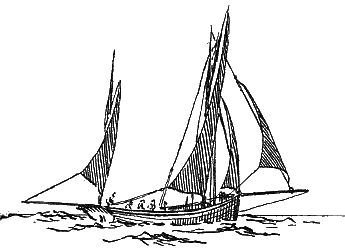 SOUTH
COAST YAWL
SOUTH
COAST YAWL
The Itchen boat brings us further west
to the strong tides and narrow channels of the Solent,
where short tacking and quick turning are a sine qua non,
and where consequently the dipping lugsail is no longer
suitable. The local rig has always been the gaffsail, or,
as in the old Portsmouth wherry, the spritsail, with
straight leech up and down and no boom, which required no
dipping in going about, and was light and simple to
handle.
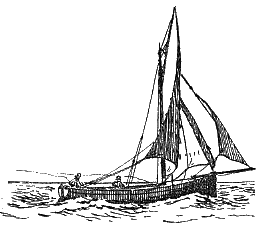 ITCHEN
FERRYBOAT
ITCHEN
FERRYBOAT
The similarity of the sail-plan of the
old Itchen boat to that of the service launch and the
quay punt and oyster-dredger of Falmouth is somewhat
striking. All are the result of a plan designed for
somewhat similar objects. The service launch is fitted
with the 'de Horsey' rig, the object of which is short
spars and snug sail and mast-plan all inside the boat. A
mainsail with perpendicular leech which is boomless for
quick handling, and a fore staysail, are the working
sails, topsail and jib-topsail being only adjuncts for
fine weather and plain sailing, just as is the case with
mizen and jib in the other boats mentioned.
SERVICE 40-FOOT LAUNCH
While the Itchen boat was used for
fishing and piloting, and was consequently a heavier
sea-going boat able to stand up to a lofty mainsail, the
old wherry which plied at Spithead as a ship's tender and
passenger boat, remained a light open skiff in
construction.
SERVICE LAUNCH--REEFED
The centre of effort of its sail area
was kept low, as should be the case in all open sailing
boats, and its masts short for going alongside shipping;
while for convenience in handling, when loaded up with
passengers or luggage, the sails were all inboard and
split up into main, mizen, and fore sails, a simple and
handy rig for any class of yacht's or ship's
boat.
OLD PORTSMOUTH WHERRY
The Solent men have always been
consummate fore-and-aft sailors, and the earliest
pictures we have of Cowes Roads show that the local
cargo-carrier was a dandy-rigged vessel as early as the
eighteenth century. On a fine morning off Gilkicker Fort
I have counted no less than eleven of these boats in
sight from the deck at one time.
Further west are two ports which have
always been strongholds of the fore-and-aft smack, which,
as pointed out, has always been the favourite rig of the
deep-sea trawler.
OLD PORTSMOUTH WHERRY
Brixham was a fishing station in the
time of the Armada, and the fore-and-aft rig was probably
developed by the Brixham men as early as the sixteenth
century. Although records are scanty, it appears that
trawling was somewhat extensively practised there at the
beginning of the nineteenth century, but the vessels and
trawls were all small compared with those of the present
day.
BRIXHAM TRAWLER
Following the intrepid wandering
spirit of their race, numbers of Brixham men settled by
degrees at eastern ports such as Ramsgate and Grimsby,
using those places as the stations from which they could
more conveniently reach fishing-grounds presenting
suitable conditions for the use of the deep-sea trawl,
which was rapidly growing in favour.
PLYMOUTH DRIFT-BOAT
It appears more than probable, indeed,
that the deep-sea trawl was first worked in the North Sea
by the west-country seamen, and was afterwards adopted by
the east coast men, first in the Thames estuary and
ultimately more widely along the coast. To this day the
big North Sea trawler differs in sail-plan from the North
Sea driving and long-line boats, and is the counterpart
of that of the Brixham and Plymouth trawling
smacks.
PLYMOUTH TRAWLER
So late as the seventies the Brixham
trawlers were all cutter-rigged vessels, from 25 to 40
tons, but since then the larger class has discarded the
long heavy boom for rough sea work, and, in common with
the majority of English fishermen, has adopted the mizen.
The result is a very beautiful class of dandy-rigged
vessel running up to 60 tons and 70 feet in length. The
time to see these boats is when they are soaring over a
south-easterly sea with a gale of wind, with topsail set,
and travelling dry and comfortably at eight or ten
knots.
A marked characteristic of the
west-country trawler is the forward rake of both masts,
which is more pronounced than in those of the east coast
ports. The 'mumble-bee,' the small class of Brixham boat,
still retains the cutter rig.
The Plymouth men, who followed near on
the heels of Brixham in the use of the trawl, have held
on to the cutter rig somewhat longer than the large
Brixham boats, and in the eighties as a boy one used to
see with admiration these splendid smacks beating to sea
in the heaviest weather with the huge mainsails
close-reefed and storm jib bending the bowsprit (which
seldom had a bobstay) like a trout rod, as the high,
straight bow soared over the big Atlantic roll. In the
drift-fishing, however, Plymouth men prefer West Cornwall
built boats either with the Cornish Lugsail or dandy rig;
but they seldom keep their boats or gear in the same
smart condition as do the Cornishmen.
Westward of these ports comes the
rugged coastline of Cornwall, with its many creeks and
coves, all of which give protection to a seafaring
population owning and working their own little
sailing-craft.
While mining in the Duchy is decaying,
and agriculture but holds its own, the fisheries give
employment to some 50,000 souls, and a large number more
follow the sea in deep-water ships, and especially in the
smaller classes of coast traders. Scarcely a creek or
pier of any size but owns its topsail schooner or its
ketch, often beautifully modelled and finely canvased, or
its old-fashioned smack of a hundred years ago, engaged
in local cargo-carrying to Wales or up-Channel, or in
foreign voyages to French and Spanish ports. Just as in
the time of Queen Elizabeth, so to this day these little
vessels of 200 to 300 tons journey fearlessly about the
stormy western seas, across the Bay, or to the cold North
Sea. Their reward is less than in those cheerful times,
and nothing is ever heard of their quiet daring. Yet any
day from the midst of the winter night-rack a small
staggering bit of a ship with three or four feet
freeboard comes in dripping to the pier-side, quietly and
without noise or fuss, as if from across the bay; safely
moored and with ropes coiled down, the skipper (who is
often as not the owner) and his crew leave her to go up
to their homes on the cliff above, and inquiry will
elicit the fact that they U have not been home for three
months, and have sailed some thousand miles since last
their vessel lay in the snug home-berth. A few days. and
they are at sea again; winter, summer, or equinox alike,
when the liners put back, and the lifeboats are out, no
less than when the white-sailed yachts go forth, they are
steadfast at their work, earning the modest profit or
more modest share or wage which is their
living.
The Cornish Lugger
The rig of the Cornish fisherman is
the lugsail in its most simple and most powerful form. In
the little open boats of 20 feet keel, as in the big
decked boats of 40 tons measurement, the favourite rig is
the dipping lug-foresail and standing lug-mizen; and for
the wild seas they navigate no more suitable rig could be
devised. As nearly every Cornishman, whether miner or
fisherman, has been brought up to 'knaw tin,' so, whether
fisherman or miner, he has it somewhere in his blood to
handle a lugsail boat.
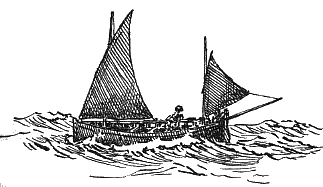 LONG-LINER,
OFF LAND'S END
LONG-LINER,
OFF LAND'S END
I doubt if any finer boatmen are to be
met with than the crabbers and long-line fishermen, whose
little open boats may be seen hauled up inaccessible
cliff paths in the rough exposed coves among the cliffs,
or ranging wide at sea twenty or thirty miles from their
capstan in any weather that a boat may live in, and in a
good deal that theoretically it may not.
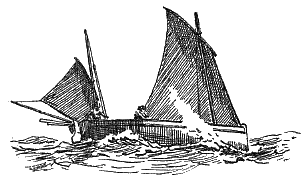 LAND'S
END CRABBER
LAND'S
END CRABBER
The majority of these boats are about
20 feet keel, some range up to 23 or so, but they become
too big to handle in the cove if they exceed that. They
have straight stems, high sides, beam about one-third of
their length, and transom-sterns. They are all open, with
four or five thwarts, with light bulkheads underneath
them dividing off the ballast-room from the fish, and so
on.
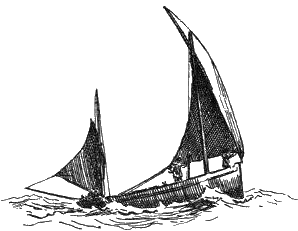 30-FOOT
PILCHARD BOAT
30-FOOT
PILCHARD BOAT
The floors inside are generally built
fairly high up, and a pump is fitted in front of the
helmsman, draining overboard.
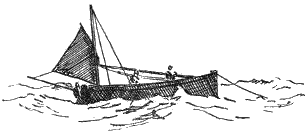 LIZARD
LONG-LINER
LIZARD
LONG-LINER
The mizenmast and outrigger are
generally left standing both ashore and at sea, while the
foremast is lowered down aft when the rolling
fishing-ground is reached or the boat is grounded in the
cove.
The mizen is often stepped some way
inboard, so that the helmsman sits abaft it. As in the
larger boats, the sails are seldom reefed, but as the
wind increases a smaller mizen is set and the large one
moved forward and set in place of the foresail. As Wyllie
has been the interpreter in colour of the Thames barge,
so Napier Hemy has made these little craft and the
rolling green seas of the Cornish coast familiar to all
picture-lovers.
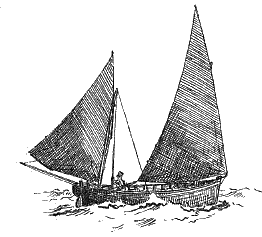 MOUNTS
BAY CRABBER (BIG SAILS)
MOUNTS
BAY CRABBER (BIG SAILS)
But it is in the more protected ports
and bays along the Cornish coast that these boats have
been developed into as fine a type as is to be met with
in any sea of the world. The fame of the Penzance luggers
is worldwide among seamen, and justly so. But although
the boats are registered under the letters P.Z. at the
port of Penzance, they in reality hail principally from
the three picturesque fishing-ports of Newlyn,
Porthleven, and Mousehole. The first of these has won a
distinctive- name in the world of art, the second is
scarcely less renowned for the admirable quality of the
work turned out by its boat-builders, who supply distant
fishing-ports as far north as the Tyne with some of their
finest, fastest drift-boats. Mousehole, if the smallest
and least known of the three, could, not so many years
ago, at least claim the distinction of being unsurpassed
for the strength and variety of its smells.
MOUNTS BAY DRIVER WITH TOPSAIL,
CLOSE-HAULED
These boats, and those of St. Ives, a
little port quite distinct upon the north coast, have
followed the inevitable rule; as competition and the
greater distances to be covered in search of fish have
forced their crews to go further afield, they have
increased of recent years in size as well as in number,
and many of the larger boats run to over 50 feet in
length. The proportion of one-third beam is pretty
regularly maintained, with a draught of 6 to 7
feet.
Although a certain number of these
boats retain the transom-stern of their smaller brethren,
in which plenty of width aft is a desideratum, and some
of the larger modern boats have tried the counter-stern,
most of them are built stem and stern alike. And it is
the fulness and boldness of the curves at the quarters
leading off to the stern-post that form one of the
handsomest features of the west Cornish boats, and give
them a peculiar appearance when heeling even at a
considerable distance.
PORTHLEVEN LUGGER
The origin of the build of stern in
these boats is said to be in the smallness of their
harbours. Lying side by side they may be seen in
Mousehole or Porthleven at any time, so closely packed
that there seems to be no room for a single other boat.
Yet two or three more will come running in from the
offing, round the pier-head, and finally wedging their
bows into the angle formed by two sister boats, force
them apart, and so make a berth. Such situations make
over hanging ends or square corners de trop, and explain
the strong rubbing strakes which form so distinct a
feature of these boats.
The present extensive drift-net
fishery of the west had its beginning in the small
pilchard 'drivers,' which seldom exceeded 30 feet in
length, and were only half-decked. It was one of these
boats, commanded by John Hocking of Newlyn, which made
the passage to Melbourne in 1846, and took the mails from
the Cape. She had to lie to a sea-anchor several days in
the westerly gales on the passage from the Cape, but
otherwise was never seriously inconvenienced by
weather.
MACKEREL DRIFT GOAT
The mackerel drift-fishery has
gradually come into prominence, and the larger boats are
employed in this fishery in the spring. The usual class
is 43 to 47 feet long. A larger mesh and greater length
of net is used, and the fishery commences early in March,
the boats ---ing out to find the fish as far as a hundred
miles west of Scilly, or south from the Lizard. At this
period a large number of east coast boats from Lowestoft,
Yarmouth, and from other fishing-ports such as Shoreham,
visit the Cornish coast to participate in the mackerel
fishery.
Huge French ketches hailing from
Boulogne, 90 feet in length, and with crews of whom
sixteen may be seen on deck at a time, are also prominent
with their gay mizzen-trucks, white painted blocks, white
bow wave-line, huge spars, high sides, wide sterns, and
forming a most remarkable class of drift-fishing vessel
developed from the English North Sea fashion.
BOULOGNE 90-FOOT DRIFT-BOAT
Later on, as autumn advances, all
these 'drivers' may meet again up-Channel and off the
Yorkshire coast-the little, clean-cut Cornish luggers, or
the big east coast dandies, racing the tall-masted Scotch
'Fifies' in from the offing with their cargoes of
herrings.
For this fishery another entire set of
nets is necessary, with medium-sized mesh. On the south
and east coast of Ireland, too, at this season many
Cornish boats may be met with following the herring in
company with their Manx brethren. It is remarkable that
these Cornish boats so favourably impress the people of
the ports they visit that there are few places to which
they have found their way which do not own some
Cornish-built boats of their own.
EAST CORNWALL DRIVER
Many a 'driver' I have seen with the
letters of some distant Irish, English Channel, or east
coast port upon its bows, but having in its clean, easy
waterlines the unmistakable stamp which I knew from
boyhood, and inquiry showed she was a native of the west
country. Porthleven is building at this moment for
Lowestoft and South Shields; while the whole Manx fleet,
which when Houldsworth wrote in 1874 was dandy-rigged,
and had then admittedly adopted the mizen from the
Cornishmen, is now built and rigged exactly on the model
of the Mounts Bay boats, with a few local differences
which the keen, practical Manxmen have evolved on their
own account.
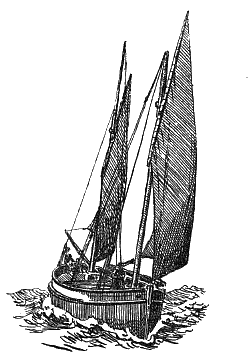 MOUSEHOLE
DRIFT-BOAT
MOUSEHOLE
DRIFT-BOAT
The long mizen outrigger would appear
to be the chief source of weakness of the Cornish lugger,
standing as it does alone without any form of stay
whatever. In order to be clear of the sea when plunging
it is topped up at a considerable angle by a huge timber
chock, generally painted white, like the rudderhead,
stemhead, and other points of the top works. Only in two
or three cases have I heard of its being carried away at
sea, and in each case it went just outside the gunwale
and was easily secured, hauled inboard, and chopped down
to fit the heel-iron, a smaller mizen being set upon it,
and the whole job completed within an hour of the
accident.
STORM-SAIL
This outrigger, often as big in
diameter as the foremast itself, is always stepped on the
port side, and as a consequence the mizen-sail is always
set to port of the mast, (this is also the rule in the
Manx boats) while the dipping foresail is of course
always set to leeward. Cornishmen very rarely carry the
sail against the mast even for a short board, whereas the
Scotch may often be seen with the tack into the mast, and
the sail standing against it. This is largely owing to
the greater hoist, size, and weight in the lofty Scotch
lug, which makes it much more difficult to
handle.
The mizenmast is slightly shorter than
the foremast to the halyard sheeve; above this, however,
is a long pole for hoisting the mizen topsail, which
makes it considerably higher than the foremast over all.
The mast is stepped a long way inboard and is given a
great rake forward, especially in the newer boats, though
it is never so excessive as that of the east coast
drift-boats, or again in the Scotch luggers. One reason
given for this rake is that it throws the sail further
inboard, and fishermen believe that the larger the sail
area inboard, the greater the speed. It is very possible
that bringing the centre of effort of the mizen further
forward conduces to less weather-helm in a breeze, and
better balance of sails, and therefore less use of the
rudder and more speed.
A HEAD-SEA
But in the Cornish boats it also
enables the mizen outrigger to be topped up higher out of
reach of the water without spoiling the flat set of the
mizen-sail.
In reducing canvas for increasing
wind, the mizen-sail is set as foresail. The tack is then
taken forward of the mast' as far as is necessary to
enable it to sheet fair to the foresail sheets without
being pulled out of shape. In the case of the smallest
storm mizen being set forward, it generally sheets fair
with the tack to the mast. The small triangular 'watch'
mizen will then be set aft.
It is noticeable that the West
Cornwall men very seldom set a jib, and although there is
a stout forestay to the mizenmast they never set a
staysail upon it as do the Manx 'Nickeys.'
ST. IVES BOAT, WITH MIZEN TOPSAIL
Yet there is no doubt that in light
winds the Cornish lugger is undercanvased and cannot
compete with the big Lowestoft dandy-rigged boats, which
carry main and mizen topsails, spinnaker, and balloon
staysails. The Mevagissey, Fowey, and other East Cornwall
boats use a light-running bowsprit and jib very much;
such a device does not add materially to the weight or
gear to be handled, and especially in reaching is a great
addition of power, the jib when well cut being
essentially a lifting sail very valuable for speed. In a
lug rigged boat in the east it was my experience that a
light bowsprit involving the minimum of gear, with a
small storm-jib set upon it, was of great value even in
beating, and involved no difficulty in handling; and one
cannot help being of the opinion that the West Cornish
boats would benefit greatly in ordinary weather from a
perhaps slightly loftier foresail, a jib and bowsprit,
and a possible mizen staysail in boats of greater length.
A large jib when close-hauled, especially if flattened in
too much, will do more harm than good to most boats; a
jib needs judgment in setting more than perhaps any other
sail except the Chinese lug. But men who take such care
of and use their sails so well as the West Cornwall
fishermen, could be trusted to get the best out of a jib
if they once adopted it for light weather.
A LONG-SEA OFF THE WOLF
Such a bowsprit as is suggested would
be a very different thing from the enormous spar with its
weight of gear, stays, and whiskers, which was considered
necessary to give the required head-sail to the old
knife-edge cutters of the seventies and eighties, and
which used to cause so much heavy plunging and be such a
cause of real weakness to those craft. Nor need it
emulate the tree-trunks used by the Boulogne fishermen as
bowsprit, which are actually little less than sixty feet
long from heel to point. A light running spar is all that
is necessary, and quite a moderate-sized sail would do in
ordinary weather.
The Cornish lugsail is probably as
near perfection in cut as any sail upon the seas, and
while the sailmaker has acquired the art of cutting, the
fisherman is no less successful in the art of setting. In
fact, of all the fishermen I know, none come so near
being yachtsmen as the Cornish. It is well-nigh
impossible to see a Cornish sail pulled out of shape by
careless stretching: hard, straight luff, full leech, and
rounded foot are all there; no concave outlines such as
are common enough further round the Channel.
An hour after her catch has been
landed, all on board the Cornish boat is scrubbed down;
not a scale remains on deck, not a spare rope-end is
loose; and all the sails are furled and stowed away
beneath the coat in a big bundle in the lumber irons.
Down below equal order reigns, and the visitor is
welcomed by a sense of cleanliness which is not by any
means usually associated with fishing-craft. And the
clean-lined Cornish boat is a yacht not only in
appearance but in speed, and especially in the highest
test to which men or vessels can be put, beating to
windward in a seaway. I have often seen a Penzance lugger
out-pointing much larger east coast fore-and-aft rigged
vessels, and at the same time outpacing them fast, making
a very close thing with a large modern-built yacht. The
most inspiriting thing that any man may see, or still
more take part in, is the beat-out of the Newlyn fleet in
half a gale from the eastward; a hundred or more racing
for the fishing-ground, like a flock of hardy,
brown-winged seabirds.
And each clean-lined boat has its own
story it could tells. They look alike enough at sundown
rolling at their nets, just as you and I are alike to the
stranger until he knows our tale. And this is the tale of
St. Michael, 55 P.Z., and many others are like unto it
with variations.
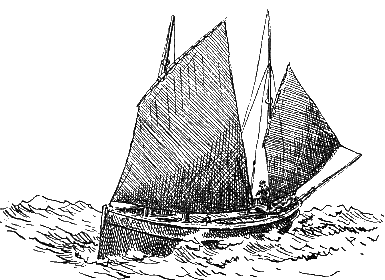 NEWLYN
GOAT - SMALL SUIT
NEWLYN
GOAT - SMALL SUIT
St. Michael was new at that time, and
had a counter-stern like an east-country boat's, and but
little luck in fishing; small catches and damaged nets
too often. There was the skipper, Roger Sennett, my old
friend, and there was a crew of six men and the boy; one
of whom being ill, Uncle Dick went in his place. Now
Uncle Dick had been to South Africa and had made his
'fortun,' such as Cornish miners reckon it. And by reason
of his being sick with a dose of malaria which could not
be parted from him, he was wearing all that a deep-sea
fisherman wears in winter, including vast sea-boots and a
complete set of oilskins. It was thirty miles off the
Lizard lights when everything was ready in the St.
Michael to shoot the nets for the night. She was running
down-wind with small mizen and foresail, and the big
westerly seas rolled up astern, backed by the fierce
breeze, which with a falling glass threatens a nasty
night for all who must be at sea. And as she was
cautiously jibbed preparatory to bringing to, to lower
sail, the boy against orders got down to leeward, and
when the foresail sheet gathered itself up and with the
crack of a pistol went rigid as a bar of steel, it caught
the astonished boy beneath the armpits and hoisted him
instantaneously and irresistibly into the air, shooting
him twenty yards away into the glooming seas. Uncle Dick
stood on the weather quarter and saw; lie turned quickly
round, and as he stood plunged over the stern after the
boy. The cry of 'man overboard' does not avail to bring a
vessel into the wind when running at nearly ten knots
before an Atlantic blow. With helm hard down and all
hands hardening in the sheets, she will be four hundred
yards to leeward in the time that you can say it. So the
sweeps and all available floating stuff which minds
accustomed to act impelled overboard after the lost men,
were rising and falling, almost lost to sight in the
spreading night to windward, by the time St. Michael had
brought herself up to meet the seas. The quick eyes of
the younger hand saw how far still to windward were those
two small heads rising, falling, and fighting watery
death. Quickly he threw off his clothes, and with the end
of a small line in his teeth sprang overboard to join
them, and left his four mates to work the boat in time,
if possible, over the lost ground. Then came the long
struggle in which each simple heart seemed to live a
lifetime. While the boy soon had to act rescuer to the
old man spent by sickness and encumbered with his vast
weight of clothing, the new arrival collected all he
could of the floating stuff and fought his way to his
fast-drowning shipmates. 'Cheer up, Uncle Dick; hold on,
uncle,' kept saying the boy, 'here she conies. I see
Roger's face quite plain, I do.' At length all were
alongside, but in the heavy sea it was almost impossible
to get the exhausted men on board, and when at length it
was accomplished with the aid of a tackle, it was over an
hour before Uncle Dick returned to consciousness, and the
nearest drop of available stimulant was, Cornish fashion,
in Penzance harbour, fifty miles to windward. And thither
they had to go for it.
That and the like is what St. Michael
thinks about riding to her buoy at nights. When they get
a yarn at a quiet anchorage, others can cap hers for
grimness but not for bravery, and few end so well. Did
not the Lone Star see the Alary founder with all hands
close beside her inside the Wolf? Has not the Blue Bell
twice lost a hand on the passage to Ireland? How many
boats can tell of the terrible runs for shelter in the
violent winter gales, of three boats pooped and smashed
to matchwood by the furious Atlantic combers within two
hundred yards of the harbour pier? Such are the secrets
of Mounts Bay boats, which they do not brag about, but
which one who knows their history is not likely to forget
even of a summer's evening when they all go forth
glorious in topsails and big new foresails.
And a word for the strong,
gentle-hearted, adventurous men who form their crews:
learned in the Scriptures and the sea, ignorant of the
world; easy going like all sons of the wave, lazy as the
hustled business man counts laziness, but tenacious of
convictions; able, very able (but not always willing) to
act, ready generally to ' prache' or sing a hymn; slow to
leave port, but fearless out at sea; narrow-minded
perhaps, as it is reckoned by some; most kindly
certainly, friendly, hospitable, and ever ready above all
men to bear a hand to him who needs it upon the water.
Such are my old Cornish friends, their own musical
natures bitten of the old sea spirit.
Falmouth Estuary
Just as the Solent with its strong
tides and narrow channels has become the home of a
fore-and-aft class of boat, so similar conditions in the
beautiful estuary of the Fal, with its many creeks and
winding wooded reaches, although set in the midst of a
lugsail coast, have made it the home of a distinct class
of deep, well-ballasted boat, carrying the gaff and boom
mainsail, stay foresail, and jib.
The quiet old-world villages at the
head of the many coves which lie along the indented
coastline about the Fal estuary own a number of these
boats varying in size and finish. Nearly all have great
depth for their length, straight stem, transom-stern,
waterways along the sides, and a fore-deck extending to
the mast, and very high freeboard.
THE FAL ESTUARY
Flushing, Pill Creek, Restronguet, St.
Just in Roseland, and half a dozen other snug,
wood-fringed anchorages have their little fleet, lying
with bow-ropes among the primroses, and ready for use in
the hundred and one ways which a waterside population
with the sea instinct know. Oyster-dredging,
mackerel-whiffing, long-lining, or crabbing, as the
season suits, or even a cargo of wood or a
pleasure-party-all have their turn. And better cut,
flatter setting mainsails not even the Solent can
show.
The Falmouth quay punt is the
well-known class of Fal estuary fore-and-aft rigged boat,
and is used for taking off stores to ships lying in the
roads of that splendid harbour, and for long-lining,
crabbing, drift-fishing, or pleasuring as the case may
be.
There is nearly always a large fleet
of deep-water sailing ships lying at anchor in the
capacious anchorage of the harbour, waiting for orders,
and bound to and from such distant ports as Calcutta,
Rio, or Sydney.
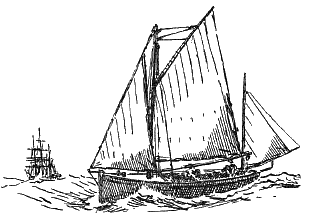
FALMOUTH QUAY PUNT--WINTER RIG
The quay punts may be seen all the
year through going alongside the ships with any stores
which may be required, such as beef, flour, or coal, or
taking off anchors, cables, and rope. As they must go off
in all weathers, they are half-decked with waterways
round the large open cockpit, and are high-sided,
deep-hulled boats; the winter rig is a snug and handy
one, consisting of jib-headed mizen, small gaff mainsail,
fore staysail set on a short iron bumkin beyond the stem.
The gear and rigging are of the simplest, and can be
quite easily handled by one man in any weathers. For
summer wear a longer mast and larger set of sails are
used, and standing lug-mizen, balloon staysail and jib
set on a running bowsprit may often be seen. By reason of
their straight stem, transom stern, and very high side,
and the comparatively short pole-mast preferred for going
alongside shipping, these boats are not very taking to
the eye. But when handsomer-looking craft begin to cry
for shelter, the quay punt is just beginning to feel in
her element, and to show her qualities; and whoever has
had experience of these boats when the south cone is
hoisted, when the wind has 'dropped' or 'backed to the
south-west, and a 'rubbly' sea as they know it is running
in the bay, is aware that for speed, handiness, and
stiffness in bad weather there is nothing of their size
to equal them.
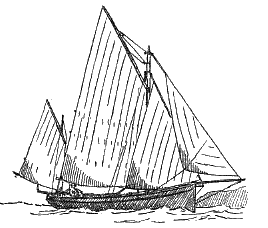 QUAY
PUNT--SUMMER RIG
QUAY
PUNT--SUMMER RIG
Quick in motion owing to their short
ends and heavy ballasting, they seldom take any heavy
water, although they throw it freely. Many hard winter
blows they come through safely. The dangerous time is
when they are out 'seeking' (i.e. looking out for ships.)
off the Lizard. As the Atlantic depressions approach
these coasts, the west and south-west winds with which
they are heralded fly suddenly to the north-west and blow
with great violence.*1 When caught offshore in these
blows it is a hard beat up, and occasionally a quay punt
has had to run away east, or has got lost, it was
supposed, in the Race off the Lizard. But as a rule, with
close-reefed mainsail and foresail, the quay punt stands
up to anything, and will weather in against the hardest
'puffs' or squalls of the bitterest nor'-wester. At a
certain angle of heel the boat seems to refuse to list
further, and it is simply a case then of hanging on and
not being washed out of her.
About forty of these boats are owned
in and about the town of Falmouth alone. Formerly they
seldom exceeded 22 feet in length, but the need for speed
developed in racing off to ships has produced a bigger
type of boat, and they now run to 24, 28, or even 82 feet
lode-water length. The draught of a 24-foot boat would be
nearly 6 feet, beam 7 feet, and ballast about 8 tons,
there being generally in the newer boats a considerable
iron keel. The large cockpit is used for placing stores
in, and about two tons can he carried at a time in the
worst weather, while in the summertime it affords plenty
of accommodation for a pleasure party. The usual cost is
from £80 to £100.
*1* Just as in the Baltic the North-Wester is reckoned
the most violent gale, and in one's own experience
more accidents happen with the wind in this quarter
than even with the the south-west and south-east
gales, which often drive in an actually heavier sea,
but which have less sheer ferocity and hitting power.
Like other Cornish ports such as St.
Ives, Penzance, etc., Falmouth had a fine class of
six-oared gigs for pilot and other duties. These boats
are getting rare now, but may still occasionally be seen
moving very fast with their low, long-yarded, lateen-like
lugsail set in a short forward raking-mast.
ST. IVES GIG
The small punts or dinghies of
Falmouth and other places on this coast are usually
rigged with a small standing lugsail right in the bows,
and a little jib-headed mizen a very handy, light rig for
any dinghy for yachting or rough work, placing the
steersman well between his sails, and exhibiting fully
the value attaching to a mizen for small craft in rough
and stormy waters.
PENZANCE GIG
These little boats are generally under
14 feet in length and are carvel-built, with a straight
stem, sharp entry forward, and flat floor carried well
aft. They are used for ferrying passengers and for
dredging oysters and other fishing work.
SERVICE WHALERS
They are at very smart class of neatly
built little vessel, and with one or two men are handled
in any weather. A dozen or more may be met single-handed
on the oyster-beds in the roughest equinoctial winds,
kicking lightly over the flying green seas, and no finer
display of fearless watermanship can be seen.
OYSTER SKIFF
One of them I once met outside,
running in before a strong sou'-wester, with the peculiar
sprit mainsail which the western men like, in shape very
similar to the old Brighton hoggies, with her two hands
in their oilies standing up in her looking out for their
crab-pot buoys. How they kept their feet as the tiny
craft, with scarcely 16 inches freeboard, rolled and
lurched top-heavy before that wind and sea was a mystery,
and we watched them with admiration.
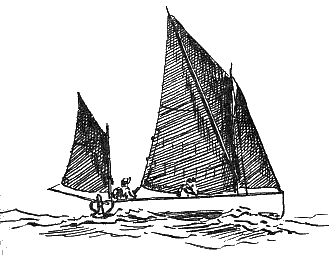 SPRITSAIL
CRABBER
SPRITSAIL
CRABBER
For we were being shaken off our feet
by the violent plunging of our much larger
craft.
This spritsail rig, which is a
favourite for open boats in the west country, as it used
to be in the Thames and at Spithead, has much to
recommend it.
The mizen, whether leg of mutton or
spritsail, is always a handy sail, and makes up for lack
of a long main boom over the stern, with the advantage
that it needs no looking after and does not press the
boat down. I am aware that some sailors, not accustomed
to the mizen, often find it an additional thing which it
is a worry to have to think about; but the professional
fishermen and those who are brought up to it know its
value, and are aware how little looking after it really
needs. The sheet can be always let go, and the sail
furled standing on the mast in a trice.
The foresail, balancing the mizen,
when set on a bumkin over the bows is a lifting sail, and
if cut high in the foot will never hold water or press
the boat down. It has the advantage of' being right
forward out of the way, and can be kept standing when
manoeuvring under oars, or working lines or
pots.
GERRANS CRABBER
The sprit mainsail is unequalled for
shape and handiness if properly set. For this there must
be a purchase to the grommet at the heel of the spreet to
keep it well up. A couple of thimbles spliced into the
eye at the throat carry the simple brail which is all
that is necessary for taking in the sail. There is no
boom, so dangerous and inconvenient in an open boat, but
one can always be fitted if thought necessary. The sail
is better without, and can be spilled more
instantaneously in a squall than when a boom is
used.
Although for windward work in open
boats the big balance-lug, with its uncompromising lacing
to the boom, is undoubtedly the most powerful in fine
weather, after an extensive experience with both from the
days of early boyhood, the palm for all-round handiness,
and for results under all conditions, must, where open
boats are concerned, be awarded to the sprit main mizen
and fore-sail rig as used in the old Thames hatch-boats,
in the Portsmouth wherries, and by the west-country
boatmen. And no rig is prettier to the eye when well-cut
and made by a good Falmouth or Penzance sailmaker, and
fitted in a good centre-board boat.
The iron-bound coast of North Cornwall
and Devon has few harbours of note, and the trawling of
the Bristol Channel has been in the hands chiefly of the
enterprising men of Brixham, who have done much to make
Milford Haven a fishing-port on the west as they did
Ramsgate, Lowestoft, and Grimsby in the old days on the
east.
The Isle of Man
In 1870 the favourite rig of the Manx
fisherman was the dandy. Quite a number of boats then
owned in the island for the long-lining and drift-net
fisheries had adopted the mizen from the Cornish boats
which they met when visiting St. George's Channel or
fishing in Irish waters. The rig before that time seems,
as far as records go, to have been the smack or
cutter.
In build and lines the Manx dandies
were very similar to the Cornish boats, the sharp stern,
full round quarters, and straight bow being almost
identical, but it is not clear how far it was indigenous
to the island. In scarcely twenty years, however, the
whole Manx fleet changed into the lug rig, and by 1890 it
had openly adopted the Cornish style of rig as well as
builds.
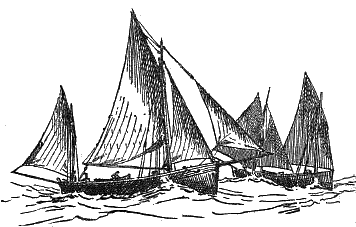 MANX
DANDY
MANX
DANDY
So far the Manx seamen had shown
themselves to be capable imitators of a serviceable type
of vessel eminently suited to the rough seas about their
island. It did not take them long to effect considerable
improvements, and in the matter of size they have far
out-classed the general run of Cornish boats, running to
10 or 20 feet greater length, and proportionate increase
of tonnage, length of net, and number of crew.
A prominent addition to the sail area
forming a characteristic feature of the Manx 'Nickey' is
the big staysail carried between the masts on the mizen
forestay. It is reasonable to inquire what has made the
Manxman leave the smack for the dandy rig, and the dandy
the lugger, thus reversing the development which has
taken place at Yarmouth on the Norfolk coast, where the
old luggers of the seventies of the last century have
given place to the ketch or dandy, not only for trawling
but also for the drift-fishing and all
purposes.
MANX NICKEY
The adoption of the mizen in the
smack-rigged vessel is explained by its convenience for a
boat lying to nets in keeping the head to sea, and the
superior handiness of the smaller mainsail over the
heavier boomed sail of the cutter rig, especially where
the mast was made to lower down aft, as is generally done
in drift-boats.
The reasons which probably led to the
adoption of the fore-and-aft rig on the Norfolk coast
were pointed out above. These reasons did not exist in
the Isle of Man, which is surrounded by wide seas where
long tacks are made and where rough weather is the
rule.
The simplest possible form of rig,
with the mizen and with the least gear about the
mainmast, naturally commended itself. The weatherly
quality of the lugsail observed by the Manxmen in the
Cornish boats had much to do with the selection, and as
the Manx crews are all seamen to the bone the big dipping
lugsail necessary in the larger-decked boats had no
disadvantages to their minds, and in fact they handle it,
as they do all connected with their craft, in the most
fearless and seamanlike manner. As they increased the
length of their boats the Manxmen soon added the mizen
staysail to fill the increasing gap between the foresail
and mizen, the greater length enabling this to be done
without spilling wind from either sail.
CASTLETOWN NICKEY
Although the sails are not always made
and set quite as well as those of the Cornish boats, and
concave foot and leech are often noticeable, yet the
boats are among the smartest and cleanest of our coasts,
and running to the size they do they are second to none
in power or seagoing qualities.
FLEETWOOD SHRIMPER
Although some saintly mariners appear
to have gone to sea from Ireland at various times between
the sixth and ninth centuries, it is curious that the
mast and sail have never been greatly developed by the
modern Irish and without doing them an injustice it may
be said that they have never been a seafaring
race.
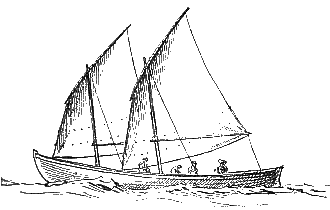 GROOMSPORT
YAWL
GROOMSPORT
YAWL
St. Perran performed a remarkable feat
of seamanship when he navigated a millstone to Cornwall,
but I believe he was not an Irishman, although at that
time sailing from an Irish port; nor do the Irish appear
to have wished to emulate the performance, which seems to
have been regarded as rash even in a saint.
To come to more recent times, it is
true that cutter-rigged craft appeared on a map of
Ireland in the sixteenth century, but this fact does not
throw any greater light on Irish seamanship of the
period. The Galway hooker is probably the only eminent
boat of a sea-keeping type now in existence which is
indigenous to 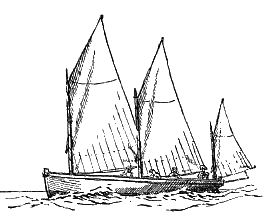 the
Emerald Isle, and the native genius of the race in regard
to naval architecture of sailing-craft has been confined
to some not very advanced lugsail boats of canoe type,
such as the Groomsport yawl or Galway pookhaun. What
large fishing-boats are owned or manned in Ireland have
been mostly acquired from the Cornish, Manx, or Scots
fishermen who frequent and fish in Irish
waters.
the
Emerald Isle, and the native genius of the race in regard
to naval architecture of sailing-craft has been confined
to some not very advanced lugsail boats of canoe type,
such as the Groomsport yawl or Galway pookhaun. What
large fishing-boats are owned or manned in Ireland have
been mostly acquired from the Cornish, Manx, or Scots
fishermen who frequent and fish in Irish
waters.